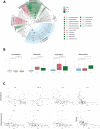Towards a personalized prediction, prevention and therapy of insomnia: gut microbiota profile can discriminate between paradoxical and objective insomnia in post-menopausal women
- PMID: 39239112
- PMCID: PMC11371979
- DOI: 10.1007/s13167-024-00369-1
Towards a personalized prediction, prevention and therapy of insomnia: gut microbiota profile can discriminate between paradoxical and objective insomnia in post-menopausal women
Abstract
Background: Insomnia persists as a prevalent sleep disorder among middle-aged and older adults, significantly impacting quality of life and increasing susceptibility to age-related diseases. It is classified into objective insomnia (O-IN) and paradoxical insomnia (P-IN), where subjective and objective sleep assessments diverge. Current treatment regimens for both patient groups yield unsatisfactory outcomes. Consequently, investigating the neurophysiological distinctions between P-IN and O-IN is imperative for devising novel precision interventions aligned with primary prediction, targeted prevention, and personalized medicine (PPPM) principles.Working hypothesis and methodology.Given the emerging influence of gut microbiota (GM) on sleep physiology via the gut-brain axis, our study focused on characterizing the GM profiles of a well-characterized cohort of 96 Italian postmenopausal women, comprising 54 insomniac patients (18 O-IN and 36 P-IN) and 42 controls, through 16S rRNA amplicon sequencing. Associations were explored with general and clinical history, sleep patterns, stress, hematobiochemical parameters, and nutritional patterns.
Results: Distinctive GM profiles were unveiled between O-IN and P-IN patients. O-IN patients exhibited prominence in the Coriobacteriaceae family, including Collinsella and Adlercreutzia, along with Erysipelotrichaceae, Clostridium, and Pediococcus. Conversely, P-IN patients were mainly discriminated by Bacteroides, Staphylococcus, Carnobacterium, Pseudomonas, and respective families, along with Odoribacter.
Conclusions: These findings provide valuable insights into the microbiota-mediated mechanism of O-IN versus P-IN onset. GM profiling may thus serve as a tailored stratification criterion, enabling the identification of women at risk for specific insomnia subtypes and facilitating the development of integrated microbiota-based predictive diagnostics, targeted prevention, and personalized therapies, ultimately enhancing clinical effectiveness.
Supplementary information: The online version contains supplementary material available at 10.1007/s13167-024-00369-1.
Keywords: Aging; Gut microbiota; Gut-brain axis; Insomnia; Patient stratification; Predictive Preventive Personalized Medicine (PPPM / 3PM); Sleep; Individualized patient profile.
© The Author(s) 2024.
Conflict of interest statement
Competing interestsThe authors declare no competing interests.
Figures

Similar articles
-
The predictive, preventive, and personalized medicine of insomnia: gut microbiota and inflammation.EPMA J. 2023 Nov 17;14(4):571-583. doi: 10.1007/s13167-023-00345-1. eCollection 2023 Dec. EPMA J. 2023. PMID: 38094575 Free PMC article.
-
Clarifying the effect of gut microbiota on allergic conjunctivitis risk is instrumental for predictive, preventive, and personalized medicine: a Mendelian randomization analysis.EPMA J. 2023 May 22;14(2):235-248. doi: 10.1007/s13167-023-00321-9. eCollection 2023 Jun. EPMA J. 2023. PMID: 37275551 Free PMC article.
-
3PM-guided innovation in treatments of severe alcohol-associated hepatitis utilizing fecal microbiota transplantation.EPMA J. 2024 Oct 31;15(4):677-692. doi: 10.1007/s13167-024-00381-5. eCollection 2024 Dec. EPMA J. 2024. PMID: 39635024 Free PMC article.
-
Energy metabolism as the hub of advanced non-small cell lung cancer management: a comprehensive view in the framework of predictive, preventive, and personalized medicine.EPMA J. 2024 Apr 8;15(2):289-319. doi: 10.1007/s13167-024-00357-5. eCollection 2024 Jun. EPMA J. 2024. PMID: 38841622 Free PMC article. Review.
-
Nitroproteomics is instrumental for stratification and targeted treatments of astrocytoma patients: expert recommendations for advanced 3PM approach with improved individual outcomes.EPMA J. 2023 Dec 6;14(4):673-696. doi: 10.1007/s13167-023-00348-y. eCollection 2023 Dec. EPMA J. 2023. PMID: 38094577 Free PMC article. Review.
Cited by
-
Gut microbiota: a new target for the prevention and treatment of insomnia using Chinese herbal medicines and their active components.Front Pharmacol. 2025 May 6;16:1572007. doi: 10.3389/fphar.2025.1572007. eCollection 2025. Front Pharmacol. 2025. PMID: 40395724 Free PMC article. Review.
-
Association of prebiotic/probiotic intake with MASLD: evidence from NHANES and randomized controlled trials in the context of prediction, prevention, and a personalized medicine framework.EPMA J. 2025 Jan 29;16(1):183-197. doi: 10.1007/s13167-025-00398-4. eCollection 2025 Mar. EPMA J. 2025. PMID: 39991098
-
Better objective sleep quality is associated with higher gut microbiota richness in older adults.Geroscience. 2025 Jun;47(3):4121-4137. doi: 10.1007/s11357-025-01524-w. Epub 2025 Jan 31. Geroscience. 2025. PMID: 39888583 Free PMC article.
-
The Role of Gut Microbiota in Insomnia: A Systematic Review of Case-Control Studies.Life (Basel). 2025 Jul 10;15(7):1086. doi: 10.3390/life15071086. Life (Basel). 2025. PMID: 40724588 Free PMC article. Review.
-
An analysis of electroacupuncture as adjunctive treatment for insomnia: a new perspective targeting GABA-mediated microbiome-gut-brain axis.Front Neurol. 2025 Apr 30;16:1504316. doi: 10.3389/fneur.2025.1504316. eCollection 2025. Front Neurol. 2025. PMID: 40371088 Free PMC article.
References
LinkOut - more resources
Full Text Sources

